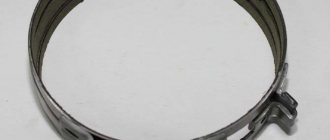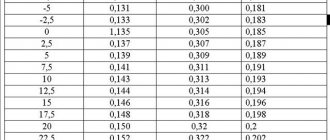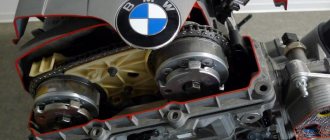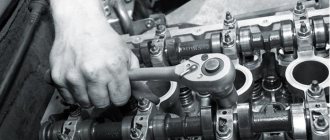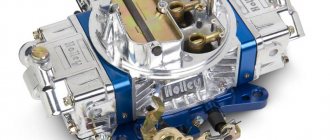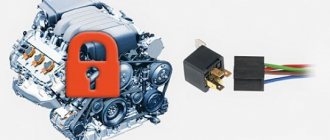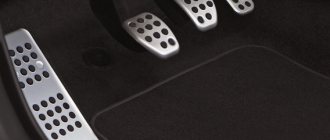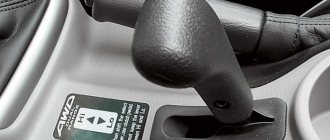For experienced drivers, systematically adjusting valves becomes a habit - this procedure has such a strong impact on the efficiency of the engine. It is the motor valves that play the leading role:
- in precise regulation of the supply of air-fuel mixture;
- in timely and complete evacuation of exhaust gases from the cylinders.
The slightest dissonance in these processes will inevitably lead to failures in the operation of hub transport systems and their costly repairs. In addition to the obvious loss of power, increased fuel consumption and exhaust toxicity, a car enthusiast may face a complete loss of engine functionality!
That’s why timely and competent checking of the valves’ performance status is the main way to avoid their radical destruction, leading to irreparable wear of the engine and its systems.
Misregulation and consequences
When the thermal clearance of the valve changes during long-term operation or when individual elements of the system break down, the efficiency of the engine and the service life of the parts are significantly reduced. This is also accompanied by increased fuel consumption and a characteristic knocking noise in the engine compartment. If, for example, the gap is larger than normal, the element cannot open completely, and this contributes to a drop in power characteristics. Burning of the valve and its seat is possible if the gap is very small. In any case, these faults have a bad effect on the engine's response when you press the accelerator pedal.
How should the elements work?
The operation of a 4-stroke engine includes 4 cycles.
Each cycle has its own purpose:
- Intake - the intake valve opens and the fuel mixture is supplied to the cylinder.
- Compression - the valves are closed, the fuel mixture is compressed.
- Power stroke - the valves are closed, the burning mixture expands, its energy is directed to move the pistons.
- Exhaust - the exhaust valve opens, exhaust gases are removed.
For the motor to operate efficiently, the clearances must be properly adjusted.
Required Tools
What you need to adjust the valves
As mentioned earlier, a probe or a special device is required. If you choose the right one, you can work with the adjustment plates. A rack is often used to adjust valves, which provides greater accuracy compared to plates or a feeler gauge. However, the adjustment process itself is different; it does not correspond to the above method. You can use an indicator. It is a special device for adjusting valves with high precision.
What are "pushers"?
Let's start with something simple (many, I'm sure, don't know what it is). In order for the upper part of the valve and the camshaft cam to run longer, so-called pushers began to be put on them. This is a cylinder, on one side it has a bottom, there is one on the opposite side (to exaggerate, it looks like a metal “cup”).
The hollow part fits onto the valve system with a spring, but the bottom rests on the “cam” of the camshaft. Since the surface of the pusher is large, from 25 to 45 mm (different manufacturers have different values), it will wear out longer than, say, just the upper part of the “rod” (which has a diameter of only 5-7 mm).
Pushers are divided into two types:
- Solid - their adjustment occurs completely by replacing the housing
- Collapsible - when there is a groove on top of the lid into which a special adjusting washer is installed. You can replace it, thus choosing the size of the thermal gap
These elements do not last forever, and they (or the washers on top) also need to be replaced after a certain mileage.
Preparing for work
For carburetor internal combustion engines:
- Remove the cover of the air filter housing, remove the filter element and unscrew the housing;
- Remove the choke cable;
- Using a screwdriver, release the accelerator rod from the plastic ends by removing the lock washer.
For injection internal combustion engines:
- Remove the brackets that limit spontaneous release of the cable;
- Remove the cable end by turning the throttle linkage;
- Unscrew the bolts holding the cable bracket;
- Release the connector of the bleeder valve, if there is an adsorber;
- Loosen the clamps and remove the air ducts;
- Unscrew and remove the valve cover.
How to use the dipstick
- The feeler gauge is inserted into the gap between the cam and the valve;
- When moving, the probe should provide some resistance;
- If the probe moves without resistance or, on the contrary, is not inserted, then the correct gap needs to be set.
What are gaps and why are they needed?
Modern modifications of engines provide for the presence of more than 2 valves in their cylinders, equipped with gaps with hydraulic compensators; this design does not require intervention. If there are no hydraulic valve compensators, their systematic adjustment is necessary (every maintenance!).
The fact is that completely closing the valve during gas expansion logically leads to the fact that the steel cylinder will not withstand the pressure and will rupture! The reason for the fatal destruction is not only in the mega Pascals acting on the cylinder wall, but also in its critical heating, reaching up to 900 degrees Celsius.
To prevent the valve from closing the cylinder silently, the pusher and the camshaft cam profile are separated by a small gap - a gap. Its size necessarily correlates with the increase in the length of the valve stem when heated and some other indicators.
Adjustment of valves
Proper adjustment of valve clearances is a process that requires skill, specific tools (feeler gauge, tweezers, etc.) and complete cooling of the engine. The clearance values of the intake and exhaust valves, the crankshaft rotation angle and other design features of the engine, as well as the sequence of its assembly/disassembly are determined in accordance with the manual for a specific car brand.
The adjusted gaps are checked twice, with permissible deviations not exceeding 0.05 mm.
How often are adjustments made?
If we talk about mileage, then it is 20-30 thousand km. Adjustment of the thermal clearances of the valves should be carried out even if you do not experience a loss of power, increased fuel consumption and black smoke from the muffler (you should not wait for the first symptoms to appear). It is best to carry out the procedure in a car service center, but if you have the appropriate tools, equipment and experience, this can also be done in your garage.
The engine is the most important part of the car, on which the operation of the car is completely based. That is why it is important to monitor the condition of the engine, carry out diagnostics, and also change consumables in a timely manner. The cause of many problems in a car (for example, knocking, loss of power) can be valves. Therefore, it is important to know how to properly adjust the valves.
Gap function
There are at least 2 valves in a car engine cylinder (maybe more depending on the car model). Through the inlet valve the combustible mixture enters the cylinder, and through the outlet valve the gases are removed. The part is driven by a gas distribution mechanism.
During operation, the motor heats up, resulting in expansion of all its elements. Therefore, when the motor is not running (in a cold state), there must be a gap between some parts sufficient for thermal expansion of the metal.
